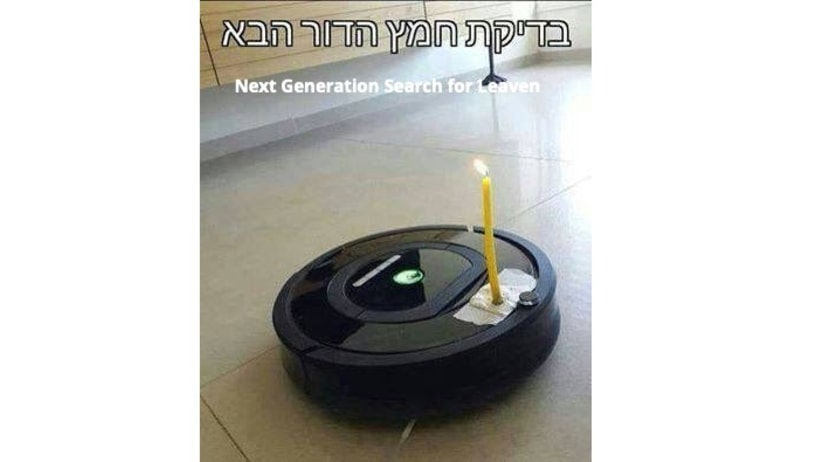Oasis Songs: Musings from Rav D
Friday, April 19, 2019 / 14 Nisan 5779
Summary: Rabbi Kosak speaks of the unusual way that cleaning for Passover can teach us about freedom and offers a suggestion for a new items to add to your seder plate.

Thoughts on Searching for Chametz
We have just finished bedikat chametz in my home, the final search for any leavening on the evening before Passover. This is primarily a symbolic search—by the time it comes, people have already cleaned their homes as thoroughly as they can manage and in a manner that meets their own sense of piety. So the search is a way we come to grant ourselves approval for the preparations we have undertaken. It may not be perfect, but we are stating that we have engaged seriously with the Torah’s commandment that leavened products of the 5 grains should not even be seen in our homes during the week of Pesach.
There is something in our souls or in our kishkes (that inner sense) that wants and needs this relationship with God and our people’s history. We desire a conversation of the body and not just of the mind, through which we wrestle with the dynamics of bondage and freedom. To put that more concretely, many folks who walk this path sometimes find themselves feeling a bit like a slave.
Getting ready for Pesach takes work, there is no getting around that. The useful Jewish language for this process is mesirat nefesh. We are engaged in a bit of soul sacrifice. The griping, the exhaustion, these are not ancillary to the holiday. They are essential, precisely because the strict requirements seem to come from an external commanding power. For some of us, that is God’s voice. For others, tradition or family custom are the compelling voice. We may choose to live Jewishly, but for a short moment, we feel in bondage to what is asked of us.
Whatever your own emotional reality is around Passover and its preparations, pay attention to it. For contained within your experience is your own lived understanding of what freedom means. Do you purchase your freedom by hiring as much help as you can to help you clean? Do you impose those duties on yourself and work yourself to exhaustion? Do you shrug and say, this is all too much, it can’t be what God wants from me? Did you grow up in a home where none of this happened, and find it difficult to grasp tight to Pesach, or to connect with they ways it teaches us about freedom?
So the search for chametz is both symbolic, and it also tells us there’s a light at the end of this tunnel—this narrow place. By the time the search is over, there’s just a bit more cooking before the seder finally arrives.
Simultaneously, the search for chametz is also quite real. This year, despite our efforts, I discovered three pieces of candy scattered in some desk drawers. That’s not too bad, and actually, it makes the seeking more meaningful. Hide and seek is never fun if no one ever finds you!
The Seder Plate, Old and New
For a long time, the contents of the seder plate never really changed. Sure, different Sages arranged the lamb shank, the egg, the green vegetable carpas in different ways, and explained why things should be ordered that way. But the items were the items. Until Susannah Heschel’s famous orange ended up on the Seder plate. Her moment of spiritual genius opened up new possibilities. Since then, many people have found meaningful items to add to the plate. If those items help to tell the story of Pesach—if they open up new understandings of freedom, then they deserve a place at the table.
Just a few days ago, Rabbi Isaak forwarded me an email about those who plan to put shoe laces on the seder plate this year. Those laces are meant to represent immigrants who have embarked on long journeys in search of freedom and opportunity. The idea came from an article in the Atlantic, here, which tells how immigrants who reach our border often need to remove their shoelaces. Apparently, there is a concern that those laces could be fatally dangerous.
I find the idea of adding a shoe lace to the seder plate quite compelling. What keeps it from becoming kitsch is the role that shoelaces have in our tradition. Abraham famously stated at the conclusion of a battle that he didn’t even take a shoe lace in payment for the help he offered. The echoes of that reverberate with our contemporary struggle as a society to determine what to do about immigration.
With that in mind, let me conclude by wishing you a joyous Pesach and leave you with another set of four questions:
Passover Shabbat Table
- What item do you think is missing from the seder plate? Why?
- When have you learned more about freedom, when it seemed farthest away or close at hand?
- Would you put a shoelace on your seder plate? Why or why not?
- If the Seder is supposed to be different from all other nights, that includes other seder nights. How will you make this seder different from other seders?
Chag Sameach,
Rav D
If you’d like to continue this discussion, follow this link to CNS’s Facebook page to share your own perspectives on the topics raised in this week’s Oasis Songs. Comments will be moderated as necessary.
Torah Sparks Commentary Will Return Next Week.



